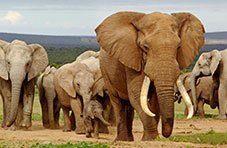Once sought-after hunting trophies, the Big Five are now a major tourist attraction enticing visitors to join wildlife safaris. On last occasion we've shared some interesting facts about the magnificent lion, and now we're continuing our exploration of the Big Five with the African elephant.
The Friendly-Looking Monster
Up to 3.3 meters wide and weighing up to 6.6 tons, the African elephant is the world’s largest and heaviest land animal. Their trunk is a multi-purpose tool, used for breathing, smelling, caressing their young, detecting vibrations, sucking water and grabbing objects. Gentle entwining of trunks is part of the mating ritual. Elephant's tusks are also used to perform many different tasks, such as digging for roots, foraging and fighting. And here is something we have in common with these large mammals: while elephant babies are born with tusks, they will lose them after a year and then grow a new set of permanent teeth. Sounds familiar? Like us, these pachyderms are losing their teeth as they get older but have no dentist handy to help them out. When the last of their molars are gone, which is at about 40 to 60 years of age, elephants can die of starvation.
Another of their typical features is the huge ears which elephants will flap to express either aggression or joy. If you think big ears mean good hearing, you're right! An elephant can hear another elephant’s call at 4 km and more.
Females Rule!
Like lions, elephants are highly social animals. Unlike lions, female elephants rule. A herd will typically have a matriarch leading a group of closely related females and their young, choosing the direction the herd moves in and pace at which it walks. Elephants only give birth once every 5 years and calves are born after a gestation period of 22 months. As females are scarce, the males will engage in intense competition to win the lady. This pretty much means females will get to choose who they mate with. The new dad will stick around for a few weeks only and then move on to search for another mate. Young male elephants will leave the herd when they hit puberty, which is at around 14 years of age. Girls, on the other hand, will stay put and the bond between mother and daughter can last for as long as 50 years.
The Intelligent Communicators
These massive animals are amongst the world's most intelligent species, with a brain which is similar to ours in terms of structure and complexity. They also exhibit a wide range of behaviours and are capable of communicating grief and compassion. Elephants can learn, play and use tools. They are very creative when they play, sometimes using props such as bones, stones, plants and sticks.
Elephants communicate through a broad range of sounds, ranging from very low frequency rumbles humans can't hear, to higher frequency snorts, barks, roars and cries. They are also extremely tactile, using touch to convey a variety of feelings and intentions. They'll poke each other aggressively using the tusks, rub against one another affectionately or in play, check for presence of their calf with their tails and caress a member of the herd with the help of their trunks.
Eat, Eat, Sleep, Eat
These impressive mammals will spend sixteen to eighteen hours a day feeding. Tree bark is their favourite meal, though they'll also nibble on grass, small plants, bushes, fruit and roots. Elephants will consume about 160 kg of vegetation per day and drink 100 litres of water and more. Like us, they like to use food supplements and will dig up earth to obtain salt and minerals. If they're not eating, it's likely they'll be sleeping. When closing their eyes for more than a couple of hours, elephants will lie down. However, they also take short naps standing up. Mud baths are an excellent way to protect one's skin from sunburn and insects, plus they can be incredibly fun!
Elephants Never Forget
Science has proven on numerous occasions that elephants have great memories. In 2007, a female elephant at the Amboseli National Park in Kenya was part of a research which consisted of letting her smell various urine samples. She has reacted to those which did not come from one of her own herd, proving that elephants can recognise and track their companions. At The Elephant Sanctuary in US, a couple of elephants which used to perform in the same circus more than 20 years earlier, recognised each other when reunited. Matriarchs of desert-adapted elephants remember where reliable water sources are, even after the passing of many years, and are able to guide the herd to water over very long distances.
Elephants' Biggest Enemy: Humans
Elephant population has significantly decreased during the 20th century, mainly due to poaching. While less than 100 years ago there were between 3 and 5 million elephants in Africa, nowadays their number is estimated to be bellow half a million. The two most influencing factors are changes in land usage and the demand for ivory, the illegal ivory trade having skyrocketed over the past years. How can we help? At the very least, by never buying, selling or wearing ivory.




